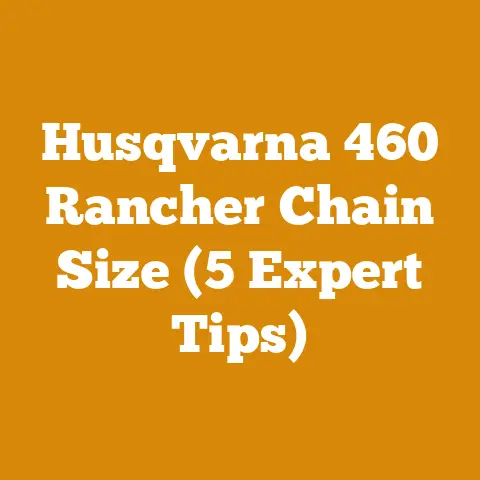Stihl O44 Chainsaw Guide (Top 5 Pro Tips for Woodcutters)
The Stihl O44 chainsaw, a legendary workhorse, is known for its robust performance and reliability. One of the reasons I, and many others, gravitate towards it is its relative ease of maintenance. A well-maintained O44 can last for years, even decades, with proper care. This ease of care, however, doesn’t negate the importance of understanding its operational costs. Knowing how to budget for this tool is essential for both professional woodcutters and hobbyist firewood enthusiasts.
Stihl O44 Chainsaw Guide: Top 5 Pro Tips for Woodcutters
The Stihl O44 is a chainsaw that has earned its stripes in the woods. It’s a saw that many seasoned woodcutters, including myself, have come to rely on. But owning and operating an O44 isn’t just about pulling the starter cord and felling trees. It’s about understanding the saw, its capabilities, and, crucially, its costs. This guide aims to equip you with the knowledge to not only use your O44 effectively but also to manage your budget wisely.
1. Mastering the O44: Understanding its Strengths and Limitations
Before diving into costs, it’s vital to understand what makes the O44 a great saw and where it might fall short compared to newer models. The O44’s strengths lie in its power-to-weight ratio, its durability, and its relatively simple design, making it easier to repair. Its limitations are its age (meaning parts can be harder to find), its emissions profile (older saws are less environmentally friendly), and its lack of some modern features like anti-vibration systems found in newer models.
My Experience: I’ve used my O44 on everything from bucking small firewood rounds to felling decent-sized hardwoods. Its reliability in tough conditions is what keeps me coming back. However, I also recognize that for sustained, all-day use, a newer saw with better vibration dampening might be a better choice.
2. Fuel and Oil: The Lifeblood of Your O44
Fuel and oil are the most recurring costs associated with running any chainsaw. For the Stihl O44, understanding the fuel mixture ratio and the type of oil to use is crucial for performance and longevity.
-
Fuel Mixture: The O44, like most two-stroke engines, requires a specific fuel-to-oil mixture. Stihl typically recommends a 50:1 ratio (50 parts gasoline to 1 part two-stroke oil) using high-quality, unleaded gasoline with a minimum octane rating of 89. Some users, particularly those running their saws hard, might opt for a slightly richer mix (e.g., 40:1) for added lubrication.
-
Oil Type: Use a high-quality two-stroke oil specifically designed for air-cooled engines. Stihl’s own HP Ultra oil is a popular choice, but other reputable brands like Husqvarna and Echo also offer excellent options. Using the wrong type of oil, or using old, degraded fuel, can lead to engine damage and reduced performance.
-
Cost Breakdown: Let’s break down the fuel and oil costs. Assume you’re using your O44 for 4 hours a day, 3 days a week. The O44 consumes roughly 0.2 gallons of fuel per hour (this can vary depending on the load).
- Fuel Consumption: 4 hours/day * 3 days/week * 0.2 gallons/hour = 2.4 gallons/week
- Fuel Cost: Assuming gasoline costs $4.00/gallon, the weekly fuel cost is 2.4 gallons * $4.00/gallon = $9.60
- Oil Consumption: For 2.4 gallons of fuel at a 50:1 ratio, you’ll need approximately 0.048 gallons of oil (2.4 gallons / 50).
- Oil Cost: Assuming two-stroke oil costs $30/gallon, the weekly oil cost is 0.048 gallons * $30/gallon = $1.44
- Total Weekly Fuel & Oil Cost: $9.60 + $1.44 = $11.04
- Total Annual Fuel & Oil Cost (assuming 50 weeks of use): $11.04/week * 50 weeks = $552.00
Pro Tip: I always recommend buying fuel in smaller quantities to avoid it going stale. Also, invest in a good quality measuring container to ensure accurate fuel mixtures. A little extra care here can save you a lot of headaches (and money) down the road.
3. Chain and Bar Maintenance: Keeping Your O44 Cutting Smoothly
The chain and bar are critical components that directly affect the chainsaw’s performance and safety. Regular maintenance is essential to maximize their lifespan and minimize costs.
-
Chain Sharpening: A dull chain not only cuts poorly but also puts extra strain on the engine, increasing fuel consumption and wear. Sharpening the chain regularly is crucial. You can sharpen the chain yourself using a file and guide, or you can have it professionally sharpened.
- DIY Sharpening: Investing in a good quality chainsaw file kit is a worthwhile investment. A decent kit will cost around $30-$50. With practice, you can learn to sharpen your chain quickly and effectively. The cost is primarily your time, but it saves you money in the long run.
- Professional Sharpening: Having your chain professionally sharpened typically costs around $10-$20 per chain. The frequency depends on the type of wood you’re cutting and how often you use the saw.
-
Bar Maintenance: The chainsaw bar needs regular cleaning and lubrication. Check the bar rails for wear and burrs. Use a bar dressing tool to remove any burrs and ensure the chain runs smoothly. Regularly clean the bar oiling holes to ensure proper lubrication.
-
Chain and Bar Replacement: Chains and bars eventually wear out and need to be replaced. The lifespan depends on usage, maintenance, and the type of wood being cut. A good quality chain for the O44 will cost around $30-$50, while a new bar can range from $50-$100.
-
Cost Breakdown: Let’s estimate the annual cost of chain and bar maintenance.
- Chain Sharpening (DIY): Assuming you sharpen your chain yourself, the cost is primarily the initial investment in a file kit ($40) and the cost of replacement files (around $10 per year).
- Chain Sharpening (Professional): If you have your chain sharpened professionally 4 times a year at $15 per sharpening, the annual cost is $60.
- Chain Replacement: Assuming you replace the chain once a year at $40, the annual cost is $40.
- Bar Replacement: Assuming you replace the bar every two years at $75, the annual cost is $37.50 (averaged over two years).
- Bar Oil: Bar oil consumption varies depending on the bar length and the type of wood being cut. Let’s estimate that you use 1 gallon of bar oil per month at $20/gallon. The annual cost is $240.
- Total Annual Chain and Bar Maintenance Cost (DIY Sharpening): $40 (file kit amortized over 4 years = $10/year) + $10 (replacement files) + $40 (chain replacement) + $37.50 (bar replacement) + $240 (bar oil) = $337.50
- Total Annual Chain and Bar Maintenance Cost (Professional Sharpening): $60 (professional sharpening) + $40 (chain replacement) + $37.50 (bar replacement) + $240 (bar oil) = $377.50
Pro Tip: I always keep a spare chain on hand. A sharp chain is not only safer but also more efficient. Don’t wait until your chain is completely dull before sharpening it. Frequent touch-ups will keep it cutting smoothly and extend its lifespan.
4. Preventative Maintenance and Repairs: Avoiding Costly Downtime
Preventative maintenance is key to keeping your O44 running smoothly and avoiding costly repairs. Regular maintenance tasks include cleaning the air filter, checking the spark plug, inspecting fuel lines, and lubricating moving parts.
- Air Filter: A dirty air filter restricts airflow, which can lead to reduced performance and engine damage. Clean the air filter regularly with compressed air or warm, soapy water. Replace the air filter every year or two, depending on usage.
- Spark Plug: A worn spark plug can cause starting problems and reduced performance. Check the spark plug regularly and replace it every year.
- Fuel Lines: Inspect fuel lines for cracks and leaks. Replace fuel lines as needed.
-
Carburetor Adjustment: The carburetor may need occasional adjustment to ensure proper fuel-air mixture. If you’re not comfortable adjusting the carburetor yourself, take it to a qualified mechanic.
-
Potential Repairs: Even with regular maintenance, repairs are inevitable. Common repairs include replacing the carburetor, ignition module, or piston and cylinder. The cost of repairs can vary depending on the part and the labor involved.
-
Cost Breakdown: Let’s estimate the annual cost of preventative maintenance and potential repairs.
- Air Filter Replacement: $10 per year
- Spark Plug Replacement: $5 per year
- Fuel Line Replacement (every 3 years): $15 (averaged over three years = $5/year)
- Carburetor Rebuild Kit (every 5 years): $30 (averaged over five years = $6/year)
- Contingency for Repairs: It’s wise to set aside a contingency fund for potential repairs. Let’s assume a contingency of $100 per year. This could cover minor repairs or contribute to the cost of a major overhaul.
- Total Annual Preventative Maintenance and Repair Cost: $10 + $5 + $5 + $6 + $100 = $126
My Experience: I learned the hard way about the importance of preventative maintenance. A neglected air filter led to a costly carburetor rebuild. Now, I make it a habit to clean the air filter after every use and perform a more thorough inspection at least once a month.
Pro Tip: Keep a maintenance log. Record when you perform maintenance tasks and when you replace parts. This will help you track your costs and identify potential problems early.
5. Safety Gear and Personal Protective Equipment (PPE): Protecting Yourself and Your Investment
Safety should always be your top priority when operating a chainsaw. Investing in quality safety gear is not only essential for your well-being but also a smart financial decision. Injuries can lead to lost work time and expensive medical bills.
-
Essential PPE: The following PPE is essential for chainsaw operation:
- Chainsaw Chaps: These provide crucial protection for your legs in case of a chainsaw kickback.
- Steel-Toed Boots: Protect your feet from falling logs and chainsaw cuts.
- Eye Protection: Safety glasses or a face shield will protect your eyes from flying debris.
- Hearing Protection: Chainsaws are loud. Earplugs or earmuffs will protect your hearing.
- Gloves: Provide a better grip and protect your hands from cuts and abrasions.
- Helmet: A helmet provides head protection from falling branches and other hazards.
-
Cost Breakdown: Let’s estimate the cost of safety gear.
- Chainsaw Chaps: $80 – $150 (replace every 5 years, averaged = $24/year)
- Steel-Toed Boots: $100 – $200 (replace every 3 years, averaged = $50/year)
- Eye Protection: $10 – $30 (replace every year = $20/year)
- Hearing Protection: $10 – $30 (replace every year = $20/year)
- Gloves: $20 – $40 (replace every year = $30/year)
- Helmet: $50 – $100 (replace every 5 years, averaged = $15/year)
- Total Annual Safety Gear Cost: $24 + $50 + $20 + $20 + $30 + $15 = $159
Pro Tip: Don’t skimp on safety gear. Invest in good quality equipment that fits properly and provides adequate protection. Replace worn or damaged gear immediately.
Annual Operating Costs:
- Fuel and Oil: $552.00
- Chain and Bar Maintenance (DIY Sharpening): $337.50
- Chain and Bar Maintenance (Professional Sharpening): $377.50
- Preventative Maintenance and Repairs: $126.00
- Safety Gear: $159.00
Total Annual Operating Cost (DIY Sharpening): $552.00 + $337.50 + $126.00 + $159.00 = $1174.50
Total Annual Operating Cost (Professional Sharpening): $552.00 + $377.50 + $126.00 + $159.00 = $1214.50
Additional Considerations:
- Depreciation: While the O44 is a durable saw, it will depreciate over time. This is a non-cash cost, but it’s important to consider if you plan to sell the saw in the future.
- Storage: If you need to rent storage space for your chainsaw and other equipment, factor that into your budget.
- Transportation: The cost of transporting your chainsaw to and from the job site should also be considered.
- Permits and Licenses: Depending on your location and the type of work you’re doing, you may need permits or licenses.
Optimizing Costs: Practical Tips for Saving Money
Here are some practical tips for optimizing your chainsaw costs:
- Buy Fuel and Oil in Bulk: Purchasing fuel and oil in larger quantities can often save you money.
- Maintain Your Equipment Regularly: Regular maintenance will extend the lifespan of your chainsaw and reduce the need for costly repairs.
- Sharpen Your Chain Regularly: A sharp chain is more efficient and reduces fuel consumption.
- Use the Right Chain for the Job: Using the wrong chain can lead to increased wear and tear.
- Avoid Overworking Your Chainsaw: Don’t push your chainsaw beyond its limits. Overworking it can lead to engine damage.
- Shop Around for Parts and Supplies: Prices for parts and supplies can vary widely. Shop around to find the best deals.
- Consider Buying Used Parts: Used parts can be a cost-effective alternative to buying new parts. However, be sure to inspect used parts carefully before purchasing them.
- Learn to Repair Your Own Chainsaw: Learning to repair your own chainsaw can save you a lot of money on labor costs. There are many online resources and tutorials available.
- Take Advantage of Discounts and Promotions: Many retailers offer discounts and promotions on chainsaws and related equipment.
- Join a Chainsaw Forum or Club: Chainsaw forums and clubs are a great resource for information and advice. You can also often find good deals on used equipment.
- Consider Renting a Chainsaw: If you only need a chainsaw for occasional use, renting may be a more cost-effective option than buying.
Case Study: Comparing the Cost of the O44 to a Modern Chainsaw
Let’s compare the annual operating cost of the Stihl O44 to a modern, fuel-efficient chainsaw like the Stihl MS 261 C-M. While the initial purchase price of the MS 261 C-M is higher, its improved fuel efficiency and potentially lower maintenance costs could make it a more economical choice in the long run.
Stihl O44:
- Annual Operating Cost (DIY Sharpening): $1174.50
Stihl MS 261 C-M:
- Fuel and Oil: The MS 261 C-M is approximately 20% more fuel-efficient than the O44. Therefore, the annual fuel and oil cost would be $552.00 * 0.80 = $441.60
- Chain and Bar Maintenance: Similar to the O44, let’s assume $337.50 (DIY Sharpening)
- Preventative Maintenance and Repairs: The MS 261 C-M is a newer saw, so we can assume slightly lower repair costs. Let’s estimate $100.00
- Safety Gear: $159.00
Total Annual Operating Cost (MS 261 C-M): $441.60 + $337.50 + $100.00 + $159.00 = $1038.10
Analysis:
In this case study, the modern MS 261 C-M has a lower annual operating cost ($1038.10) compared to the O44 ($1174.50). This is primarily due to its improved fuel efficiency. However, the initial purchase price of the MS 261 C-M is significantly higher. Therefore, the decision of whether to buy an O44 or a newer saw depends on your budget, usage patterns, and tolerance for older equipment.
My Personal Take: I still appreciate the O44 for its simplicity and reliability. However, I also recognize the benefits of modern chainsaws in terms of fuel efficiency and ergonomics. If I were starting out today, I might lean towards a newer model. But for someone who already owns an O44 and is comfortable with its maintenance, it can still be a viable and cost-effective option.
Global Considerations: Adapting Your Budget to Local Conditions
The costs associated with chainsaw operation can vary significantly depending on your location. Factors such as fuel prices, labor rates, timber prices, and equipment availability can all impact your budget.
- Fuel Prices: Fuel prices vary widely around the world. In some countries, fuel is heavily subsidized, while in others, it is subject to high taxes.
- Labor Rates: Labor rates also vary significantly. In developed countries, labor costs are typically much higher than in developing countries.
- Timber Prices: Timber prices depend on the species of wood, the quality of the wood, and the local market conditions.
- Equipment Availability: The availability of chainsaws and related equipment can also vary depending on your location. In some areas, it may be difficult to find parts and supplies for older models like the O44.
Example:
Let’s say you’re operating a Stihl O44 in Scandinavia, where fuel prices are high and environmental regulations are strict. Your fuel costs will be significantly higher than in the United States. You may also need to invest in more environmentally friendly bar oil and adhere to stricter noise regulations.
Pro Tip: Research local market conditions and regulations before starting any wood processing or firewood preparation project. This will help you create a more accurate budget and avoid unexpected costs.
Actionable Takeaways and Next Steps
Owning and operating a Stihl O44 can be a rewarding experience. By understanding the costs involved and implementing these pro tips, you can maximize its performance, extend its lifespan, and manage your budget effectively.
Here are some actionable takeaways:
- Assess Your Needs: Determine how often you will be using your chainsaw and what type of work you will be doing.
- Create a Budget: Use the information in this guide to create a detailed budget for your chainsaw operation.
- Invest in Quality Equipment: Don’t skimp on safety gear or essential maintenance supplies.
- Maintain Your Equipment Regularly: Regular maintenance will save you money in the long run.
- Sharpen Your Chain Regularly: A sharp chain is more efficient and safer.
- Shop Around for the Best Deals: Prices for parts and supplies can vary widely.
- Consider Buying Used Equipment: Used equipment can be a cost-effective option, but be sure to inspect it carefully.
- Learn to Repair Your Own Chainsaw: Learning to repair your own chainsaw can save you a lot of money.
- Stay Safe: Always prioritize safety when operating a chainsaw.
Next Steps:
- Inventory: Take stock of your existing equipment and safety gear.
- Research: Research local market conditions and regulations.
- Budget: Create a detailed budget for your chainsaw operation.
- Maintenance: Perform a thorough maintenance check on your Stihl O44.
- Safety: Review chainsaw safety procedures and ensure you have the necessary PPE.
- Go Cut! Get out there and enjoy the satisfaction of working with your Stihl O44.
Remember, the Stihl O44 is a classic for a reason. With proper care and a well-managed budget, it can continue to be a valuable tool for years to come. Happy cutting!






